
The Third Dynasty of ancient Egypt is the first dynasty of the Old Kingdom. Other dynasties of the Old Kingdom include the Fourth, Fifth and Sixth. The capital during the period of the Old Kingdom was at Memphis. After the turbulent last years of the 2nd dynasty which may have included civil war, Egypt came under the rule of Djoser and this marks the beginning of the Third dynasty. Both the Turin King List and the Abydos King List record five kings, while the Saqqara Tablet only records four.
The Abydos King List gives: Nebka, Djoser, Teti, Sedjes, and Neferkare
The Saqqara Tablet gives: Djoser, Djoserteti, Nebkare and Huni
Dating the 3rd dynasty is similarly challenging. Shaw gives the dates as being approximately from 2686 to 2613 BC. The Turin King List suggests a total of 75 years for the third dynasty. Baines and Malek have placed the third dynasty as spanning the years 2650 - 2575 BC, while Dodson and Hilton date the dynasty to 2584 - 2520 BC. It is not uncommon for these estimates to be off by more than a century.
The pharaohs of Dynasty III ruled for approximately seventy-five years. The order of the kings is based on Wilkinson. The number of years as king, the regnal years, is based on Dodson and Hilton. They have the dynasty lasting only 64 years.
While Manetho names Necherophes, and the Turin King List names Nebka (a.k.a. Sanakhte), as the first pharaoh of the Third Dynasty, many contemporary Egyptologists believe Djoser was the first king of this dynasty, pointing out the order in which some predecessors of Khufu are mentioned in the Papyrus Westcar suggests that Nebka should be placed between Djoser and Huni, and not before Djoser. More importantly, seals naming Djoser were found at the entrance to Khasekhemwy's tomb at Abydos, which demonstrates that it was Djoser, rather than Sanakhte, who buried and succeeded this king.
The Turin King List scribe wrote Djoser's name in red ink, which indicates the Ancient Egyptians recognition of this king's historical importance in their culture. In any case, Djoser is the best known king of this dynasty, for commissioning his vizier Imhotep to build the earliest surviving pyramids, the Step Pyramid.
Some authorities believe that Imhotep lived into the reign of the Pharaoh Huni. Little is known for certain of Sekhemkhet. However, it is believed that Khaba possibly built the Layer Pyramid at Zawyet el'Aryan.
The Pharaohs of the Third Dynasty were the first to have actual pyramids constructed as shrines to their deaths. Although crude, these step pyramids were the predecessors to the later Pyramids of Giza and others. The first of these pyramids was designed by Imhotep for Dzoser. Prior to, and during the construction of the step pyramids, rulers were buried in a structure called a Mastaba.
Mastaba comes from the Arabic for bench, because they look like a mud bench when seen from a distance. In a mastaba, a deep chamber was dug out and lined with stone, mud bricks or wood. Above ground, the mud was piled up to mark the grave, oblong in a shape with a length approximately 4 times its width. Although this provided a much grander tomb, it was also a much cooler tomb. This upset the early priests as it allowed the bodies to decompose due to the fact that water no longer evaporated, preventing desiccation of the bodies.
The Mastaba were the standard tomb type in early Egypt (the predynastic and early dynastic periods.
While Manetho names one Necherophes, and the Turin King List names Nebka, as the first pharaoh of the Third Dynasty of Egypt, some contemporary Egyptologists believe Djoser was the first king of this dynasty, pointing out that the order in which some predecessors of Khufu are mentioned in the Papyrus Westcar suggests that Nebka should be placed between Djoser and Huni, and not before Djoser. That the Turin King List has noted Djoser's name in red may also be significant.
In any case, Djoser is the best known king of this dynasty, for commissioning his vizier Imhotep to build the earliest surviving pyramids, the Step Pyramid. Some authorities believe that Imhotep lived into the reign of the Pharaoh Huni.
Little is known for certain of Sekhemkhet. However, it is believed that Khaba possibly built the Layer Pyramid at Zawyet el'Aryan. Huni, the last king of this dynasty, like Djoser had a renowned vizier, named Khagemni. In the Ramassid period, a text named the Instructions was ascribed to Kagemni.

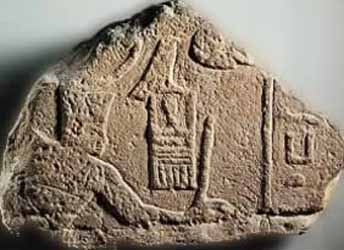
Strong Protection
Uncertainty swirls around the placement, and also the events of the 3rd Dynasty king known as Sanakhte (Sanakht). He may have been Nebka, who was known to manetho, and listed on both the Turin Cannon and the Abydos king list as the first king of this dynasty. However, this is problematic to say the least, for we base our belief that he was Nebka on a source that lists his Horus name, Sanakhte, together with a second name that ends with the element "ka" Most of the information we have on this king refers to him as Nebka. In fact, some sources list the two as separate kings, with Nebka founding the 3rd Dynasty and Sanakhte ruling later, perhaps after Khaba.
However, despite this, mud seal impressions bearing the name of Nethery-khet Djoser from the Abydos tomb of the last king of the 2nd Dynasty Khasekhemuy and connected with the burial seem to suggest that Khasekhemuy's widow and her already ruling son Djoser were in charge of the king's burial. On the basis of sealing from the tomb of Khasekhemwy, which name her as "Mother of the King's Children," the wife of the last ruler of the 2nd Dynasty seems to have been one Nimaethap. The latter name was also found, with the title of "King's Mother", upon seal impressions from Mastaba K1 at Beit Khallaf, a gigantic monument dated to the reign of Djoser. Hence, on the basis that Djoser was succeeded by Sekhemkhet and of indications pointing to Khaba as the third in line, Nebka may have been the fourth king of the dynasty, to be equated with the Nebkara following Djoser-teti and preceding Huni in the Saqqara king list.
Many theories regarding the rule of Sanakhte have been advanced, including the possibility that Sanakhte, as a member of a former ruling family, usurped the throne from the ruling family at the beginning of the dynasty. Hence, Djoser could have indeed buried his father, Khasekhemuy, and won back the throne from the usurper, Sanakhte. However, we are told that today, most Egyptologists do believe that he was a latter king of the Dynasty, even though most current documentary resources continue to equate Sanakhte with Nebka, as the 1st King of Egypt's noteworthy 3rd Dynasty who probably ruled from This near Abydos.
Little is known of this king, despite a reign of some 18 or 19 years (others might attribute a much shorter reign of from five to seven years, which would allow a better fit for him ruling before Djoser), for his reign is missing from the Palermo Stone, and important source of information on this period of Egyptian history. However, Nebka is mentioned in Papyrus Westcar. The only large scale monumental building that can possibly be attributed to him is at Beit Khallaf (mastaba K2).
His name also appears on the island of Elephantine in southern Egypt near Aswan on a small pyramid. Another of the few sources we have evidencing this king is a fragment of a sandstone relief from Wadi Maghara in the Sinai. It would seem that he, along with Djoser, began the exploitation in earnest of the mineral wealth of the Sinai peninsula, with its rich deposits of turquoise and copper. It shows the king's name in a serekh before his face.
The relief depicts Sanakhte, who is about to smite an enemy, wearing the Red Crown of Lower Egypt. We also know of a priest of Nebka's mortuary cult who appears to have lived in the reign of Djoser.
Some Egyptologists continue to believe that he may have been the brother of his famous successor, Djoser (or Zoser), or if not, perhaps his father, but apparently current thought among Egyptologists leans against this. It has been suggested that his tomb at Saqqara was incorporated into the Step Pyramid of Djoser, though little real evidence for this exists, but it has also been suggested that his is a little known monument that seems to nicely fill the typological lacuna between the Shunet el Zebib and the Step Pyramid at Saqqara.
Ancient Egyptian Pharaoh May Be the 1st Known 'Giant' Live Science - August 4, 2017
The supposed remains of Sanakht, a pharaoh of ancient Egypt, may be the oldest known human giant, a new study finds.
Myths abound with stories of giants, from the frost and fire giants of Norse legends to the Titans who warred with the gods in ancient Greek mythology. However, giants are more than just myth; accelerated and excessive growth, a condition known as gigantism, can occur when the body generates too much growth hormone. This usually occurs because of a tumor on the pituitary gland of the brain. As part of ongoing research into mummies, scientists investigated a skeleton found in 1901 in a tomb near Beit Khallaf in Egypt. Previous research estimated that the bones dated from the Third Dynasty of Egypt, about 2700 B.C.
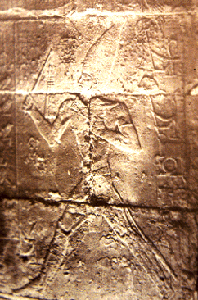
Divine of the Body
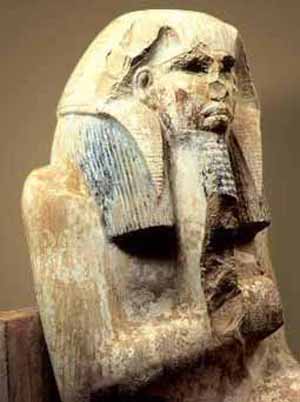
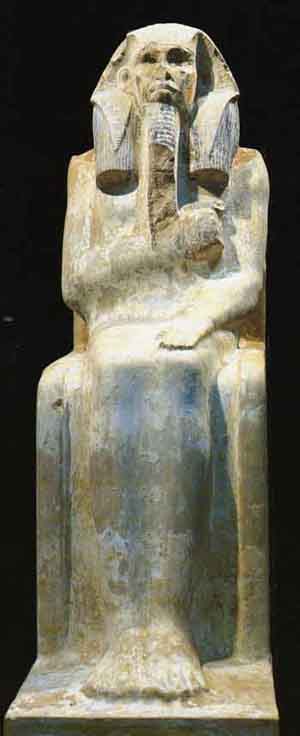
Other spellings of his name include: Zoser, Dzoser, Zozer (or Zozzer), Dsr, Djeser, Zoser, Zosar, Djeser, Djeser, Horus-Netjerikhet, Horus-Netjerichet. Djoser is the best-known pharaoh of the Third Dynasty of Egypt, for commissioning his vizier Imhotep to build his Step Pyramid at Saqqara.
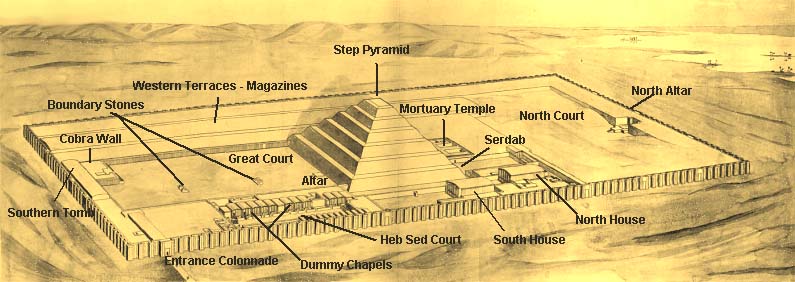
In contemporary inscriptions, he is called Netjerikhet, meaning body of the gods. Later sources, which include a New Kingdom reference to his Step Pyramid, help confirm that Netjerikhet and Djoser are the same person. While Manetho names one Necherophes, and the Turin King List names Nebka, as the first ruler of the Third dynasty, some contemporary Egyptologists believe Djoser was the first king of this dynasty, pointing out that the order in which some predecessors of Khufu are mentioned in the Papyrus Westcar suggests that Nebka should be placed between Djoser and Huni, and not before Djoser.
Manetho also states Djoser ruled for 29 years, while the Turin King List states it was for 19. It is possible that Manetho's number is a mistake for the earlier Turin King List; and it is also possible that the author of the Turin King List confused the bi-annual cattle censuses as years, and that Djoser actually reigned for 37 or 38 years. Because of his many building projects, particularly at Saqqara, some scholars argue that Djoser must have ruled for at least 29 years.
Because Queen Nimaethap, the wife of Khasekhemwy, the last king of the Second dynasty of Egypt, appears to have held the title of "Mother of the King", some writers argue that she was Djoser's mother and Khasekhemwy was his father. Three royal women are known from during his reign: Inetkawes, Hetephernebti and a third, whose name is destroyed. One of them might have been his wife, and the one whose name is lost may have been Nimaethap. The relationship between Djoser and his successor, Sekhemkhet, is not known.
Djoser sent several military expeditions to the Sinai Peninsula, during which the local inhabitants were subdued. He also sent expeditions to the Sinai where they mined for valuable minerals like turquoise and copper. It was also strategically important as a buffer between Asia and the Nile valley. He also may have fixed the southern boundary of his kingdom at the First Cataract.
Some fragmentary reliefs found at Heliopolis and Gebelein mention Djoser's name and suggest that he had commissioned construction projects in those cities. An inscription claiming to date to the reign of Djoser, but actually created during the Ptolemaic Dynasty, relates how Djoser rebuilt the temple of the god Khnum on the island of Elephantine at the First Cataract, thus ending a famine in Egypt. While this inscription is but a legend, it does show that more than two millennia after his reign, Djoser was still remembered.
Sekhemkhet was Pharaoh in Egypt during the Third dynasty. According to Manethonian tradition, a king known as "Djoserty" reigned a relatively brief seven years, and modern scholars believe Djoserty and Sekhemkhet to be the same person. His reign would thought to have been from about 2649 BC until 2643 BC.
While there was a known successor to Djoser, Sekhemkhet's name was unknown until 1951, when the leveled foundation and vestiges of an unfinished Step Pyramid were discovered at Saqqara by Zakaria Goneim. Only the lowest step of the pyramid had been constructed at the time of his death.
Jar seals found on the site were inscribed with this king's name. From its design and an inscription from his pyramid at Saqqara, it is thought that Djoser's famous architect Imhotep had a hand in the design of this pyramid.
Archaeologists believe that Sekhemket's pyramid would have been larger than Djoser's had it been completed. Today, the site, which lies southwest of Djoser's complex, is mostly concealed beneath sand dunes and is known as the Buried Pyramid.
Khaba was the fourth king during the 3rd Dynasty. He is believed to have reigned a relatively brief four years between 2603 BC to 2599 BC, although these dates are highly conjectural, based on what scant evidence exists of this early king.
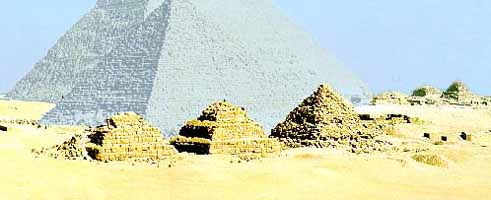
Khaba is commonly associated with the Layer Pyramid, located at Zawyet el'Aryan, about 4 km south of Giza. It is an unfinished pyramid whose construction is typical of Third Dynasty masonry and would have originally risen about 42-45m in height (it is now about 20m). While there were no inscriptions directly relating the pyramid to this king, a number of alabaster vessels inscribed with this king s name were discovered nearby in Mastaba Z-500 located just north of the pyramid.
Khaba is mentioned in the Turin King List as "erased", which may imply that there were dynastic problems during his reign, or that the scribe working on this list was unable to fully decipher the name from the more ancient records being copied from. It has also been suggested that Khaba may be the Horus name of the last king of the Third Dynasty, Huni, and that the two kings are the same person.
Khaba's name, typically displayed within a serekh rather than the more typical cartouche form established by the end of this dynasty, was written using the sign of a rising sun that had the sound value of kha, and a Saddle-billed Stork that had the sound value of ba.
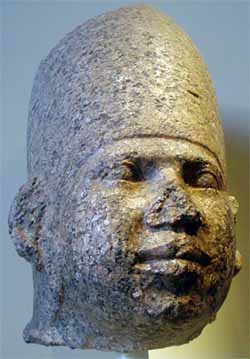
The Smiter - (2637 - 2613 BC)
Huni was the last Pharaoh of Egypt of the Third Dynasty.
Huni's wife Queen Meresankh I was the mother of Snefru. Huni was probably the father of Hetepheres, queen of the next king, Snofru.
While there is some confusion over kings and their order of rule near the end of the 3rd Dynasty, it is fairly clear who terminates the period and who also stood on the threshold between ancient Egypt's formative period and the grand courts of the Old Kingdom to follow. Huni paved the way for the great pyramid builders of the 4th Dynasty with his substantial construction projects and the possible restructuring of regional administration.
Yet, we really know very little about this king who ruled during a pivotal point in Egyptian history. The name Huni may be translated as "The Smiter". He is attested on monuments of his time by his nswt-bity name, written in a cartouche. Alternative readings have been suggested for his name, but none have been agreed upon, so he is typically called Huni even though it probably represents a corruption of his original name. He may also be one and the same as Horus Qahedjet, though this is uncertain.
In the late 1960s, a limestone stela of unknown provenance was purchased by the Louvre museum. It was inscribed with the previously unknown Horus name, Qahedjet. The stela was important to Egyptian art historians because it depicts the earliest representation of a god (Horus) embracing the king. Therefore, it received considerable attention.
Though the stela is very similar in style to the relief panels of the Step Pyramid of Djoser, the execution of the carving is superior, and the iconography is more developed. Hence, Egyptologists tend to favor a date for the stela at the end of the 3rd Dynasty. Furthermore, the Horus name for the kings who Huni succeeded have been tentatively identified. Therefore, though with no certainty, some scholars believe Qahedjet to be the Huni's Horus name
The Turin Canon provides a reign for Huni of twenty-four years, and a shorter reign than this would appear unlikely given the scale of his completed building projects. His position as the last king of the 3rd Dynasty and Sneferu's immediate predecessor is confirmed by both the Papyrus Prisse and by the autobiographical inscription in the tomb of Metjen at Saqqara.
Actually, the most impressive monument which can be relatively clearly attributed to Huni is a small granite step pyramid on the island of Elephantine. It is now thought that a granite cone, bearing the inscription ssd Hwni, meaning "Diadem of Huni", and with the determinative of a palace originally came from Elephantine. It would seem therefore that Huni built either a palace or a building associated with the royal cult on this island.
This small pyramid, together with others of similar size and construction located at Seila in the Fayoum, Zawiyet el-Meitin in Middle Egypt, South Abydos, Tukh near Naqada, el-Kula near Hierakonpolis and in south Edfu, appear to be unique, both in their size and purpose. Many Egyptologists believe that, based on the monument at Elephantine, all but the Seila pyramid may be dated to the reign of Huni. Excavations have shown that his successor, Sneferu, was responsible for the pyramid at Seila.
Elephantine is an island in the River Nile, It measures some 1.2 km from north to south, and is about 400 m across at its widest. It is a part of the modern Egyptian city of Aswan.
There has been no small amount of debate about the purpose of these pyramids. Almost all of the major pyramids in Egypt, before and after Huni, were royal tombs of some nature. However, these small step pyramids appear to have little to do with funerary practices. Many scholars have suggested, though there is little proof, that they were constructed as cult places of the king or marked royal estates.
There was, for example, an administrative building attached to the pyramid at Elephantine. Their locations suggest that there could have been one such pyramid for each nome (ancient Egyptian province), at least in southern Upper Egypt. Some have even suggested that their construction might have been associated with the reorganization of regional government during Huni's reign. Irregardless, their purpose remains unclear without further evidence for their use.
No one is certain about Huni's burial. It has been suggested that the pyramid at Maidum may have been his, and many Egyptologists seem certain that it was at least begun by him, though Middle and New Kingdom graffiti from the site credits Sneferu with its construction.
However, if Sneferu had a hand in this project, it is probable that he only finished the monument and converted it into a true pyramid. After all, Sneferu built at least two other large pyramids and was buried in one of these. Otherwise, Huni's burial remains a mystery. If he was not buried in the Maidum pyramid, than he may have been buried at Saqqara, though the only obvious location at that site, the unexcavated Ptahhotep enclosure to the west of the Djoser's complex, has no substructure. Hence, it is unlikely to be an unfinished step pyramid complex.
Some scholars theorize that the small step pyramids built by Huni somehow lessened the importance attached to the royal tomb. According to this view, Huni may never have constructed a pyramid tomb complex at all.
However, the general consensus seem to be that the Maidum Pyramid was indeed his, even though there is no evidence of there ever having been a stone sarcophagus in the subterranean burial chamber and therefore no clear evidence he was ever buried in this pyramid. Another theory suggests that he was actually buried in an unidentified mastaba number 17 on the northeast side of the pyramid, where there is a typical Old Kingdom, uninscribed granite sarcophagus.
Though we traditionally end the 3rd Dynasty with Huni, he was probably the father of the next King. It is though that the mother of Sneferu was probably Meresankh, who was either a lesser wife or concubine of Huni's. If so, Sneferu would have married his half sister, Hetepheres I, who was Huni's daughter. Little else is known about Huni's family relationships.
Huni's memory lived on for some time after his death, for the Palermo Stone lists an estate belonging to his cult during the reign of the 5th Dynasty King Neferirkara some 150 years after his death. This is really no surprise, for the achievements of Huni's reign are impressive, and he clearly ushered in the great culture of Egypt's Old Kingdom.
The structure of provincial government recorded in the tomb of Metjen probably signals a definitive break from the Early Dynastic past, and set the stage for the absolute central control of manpower and resources needed for the massive pyramid building of the 4th Dynasty.